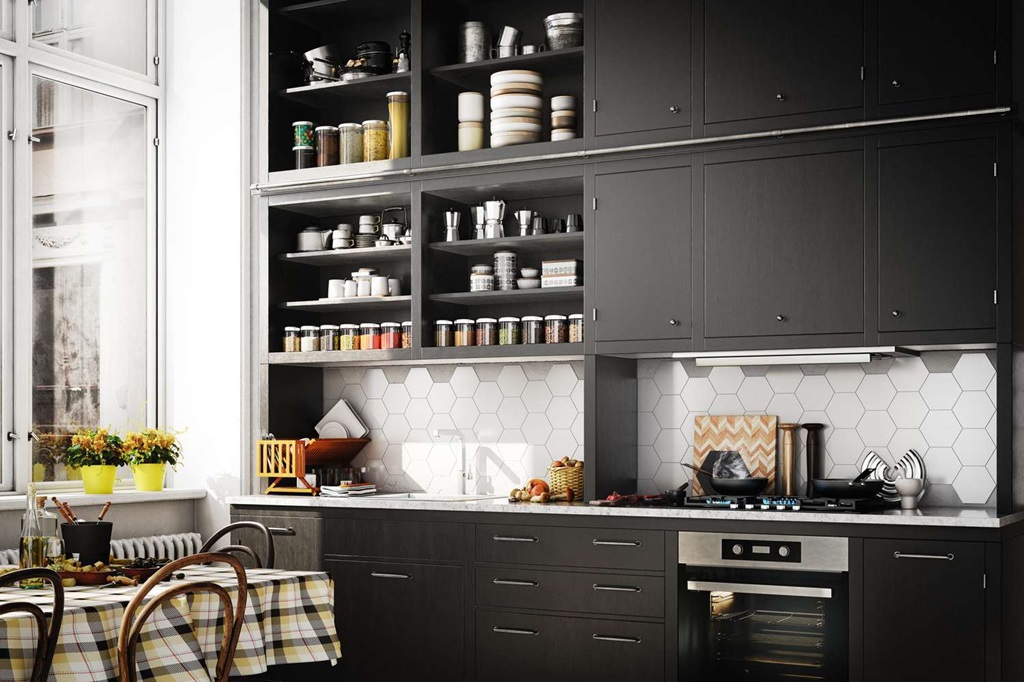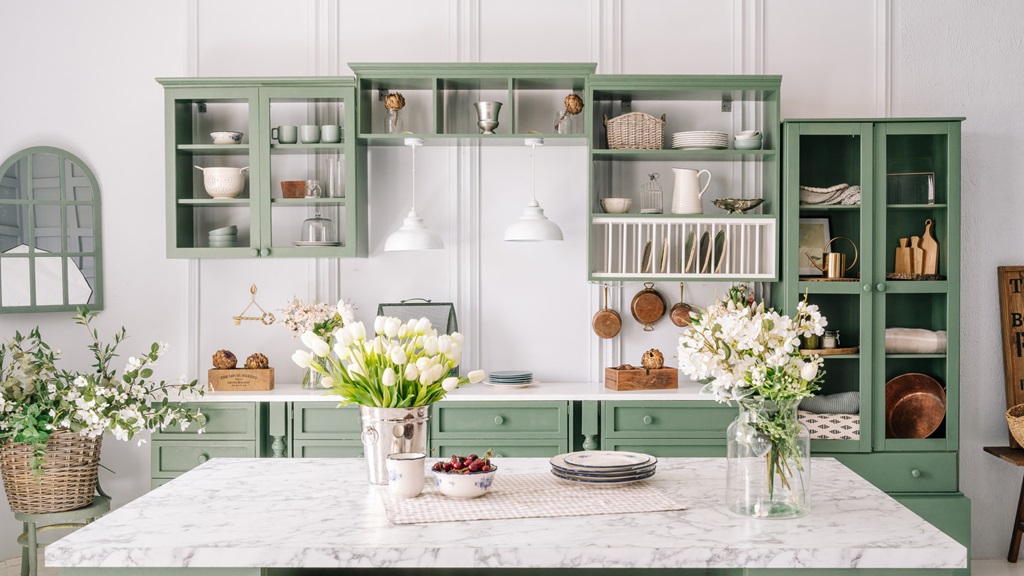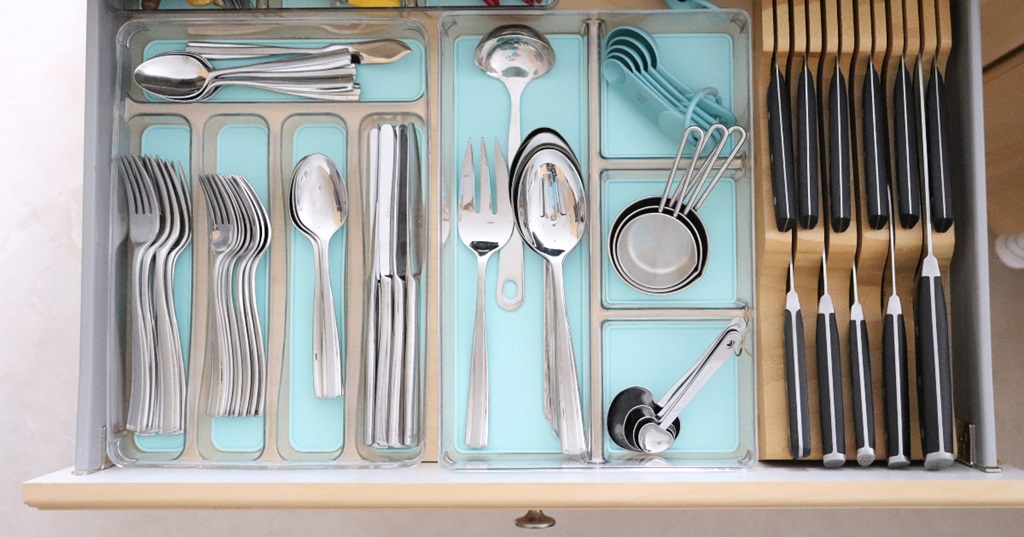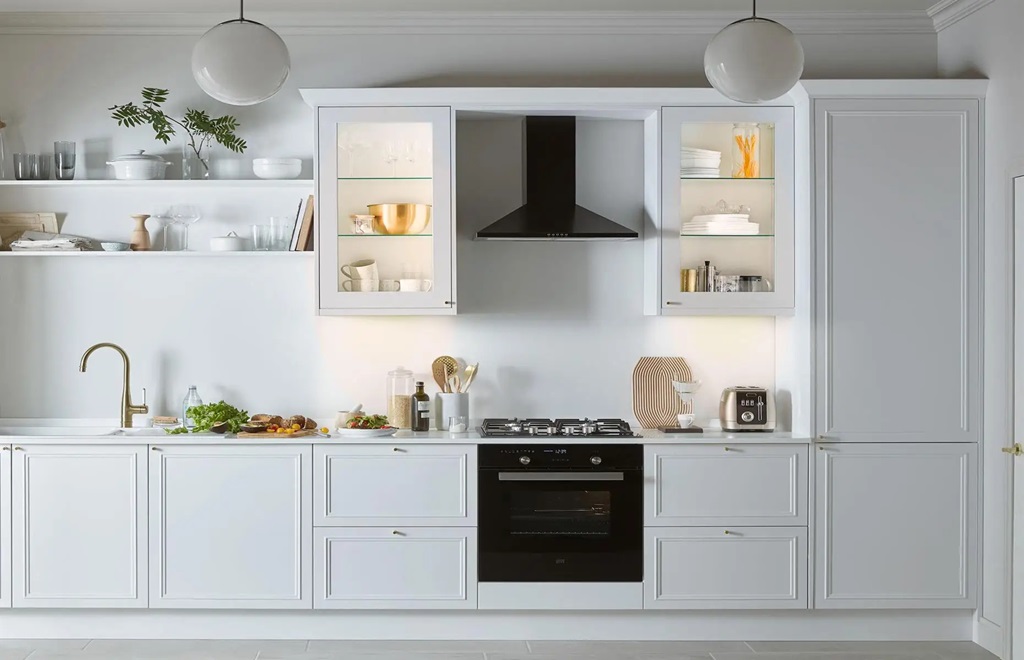
24 Dec How to Organize Kitchen Cabinets
As the heart of the home, the kitchen sees a lot of action daily. From cooking elaborate meals to grabbing a quick snack, our kitchen cabinets store the ingredients and tools we need to feed our families. However, disorganization can lead to frustration when you’re rummaging to find a specific item. By taking the time to organize your kitchen cabinets efficiently, you can save time and stress in the long run. Consider searching for some tutorials or guides online on how to organize kitchen cabinets for best results.
Assess Your Kitchen Cabinet Space
Before organizing, take stock of what you currently have stored in your cabinets. Remove everything and group like items together on your countertop, such as all baking equipment and all pasta boxes. Purge anything you don’t use by giving it away or adding it to a donation pile.
Thoroughly clean the inside of your now-empty cabinets with a mild detergent to remove grease buildup and sticky spills. This gives you a blank slate for your organizing project. Consider adding shelf liner to make wiping up future spills easier.
Categorize Items
Next, think about how you use your kitchen. What appliances do you use daily? Do you meal prep on Sundays? Making a list of how you cook and what you cook can help determine what items you access most. You likely grab your coffee mugs every morning, so keep them close by. Meanwhile, you may only use the food processor or ice cream maker occasionally.
Here are common kitchen items to categorize:
- Drinking glasses/mugs
- Plates/bowls
- Cutlery
- Pots and pans
- Baking pans and equipment
- Spices and oils
- Canned/boxed goods
- Snacks
You’ll want to store items you use together near each other. For example, keep all coffee and tea supplies on one shelf. Having a plan keeps your most-used items within easy reach.
Implement Strategic Storage Solutions

Armed with your categories, it’s time to start loading your organized contents back into the cabinets. Make the most of your cabinet space through these strategic storage solutions:
Install Shelving
While cabinets typically come with shelving, you usually need more divisions to properly organize everything. Add shelves or racks to make better use of vertical storage space. This keeps you from stacking things haphazardly.
Use Cabinet Organizers
Take advantage of cabinet organizers such as lazy susans, drawer dividers, spice racks and tiered shelves. These specialized organizers make items more visible and prevent things from getting lost deep inside crowded cabinets.
Label Clearly
Labeling helps every family member put items back in their designated homes. Use labels on the outside of cabinets to mark categories. Place labels inside cabinets to specify where exact items belong.
Store by Frequency of Use
Think of your cabinets as a filing system. Most-used items go in prime real estate at eye level within easy reach. Use hard-to-access bottom and top cabinets for equipment and serving pieces used only occasionally.
Take Inventory of Your Pantry
The pantry acts as your grocery store at home holding staples like flour and sugar as well as snacks. Start fresh by taking everything out and discarding expired items. Wipe down shelves before restocking.
Then sort items into categories, like:
- Canned goods
- Boxed goods
- Baking supplies
- Snacks
Within those groups alphabetize items so you can easily see if something needs restocking. Use tiered shelving, bins and organizers to neatly contain everything. Place frequently used ingredients on lower shelves for convenience.
Best Practices Going Forward
An organized kitchen takes commitment to maintain. But implementing these daily and weekly practices will keep order:
- Put items back where they belong after each use.
- Do a 5-minute tidy at the end of each day to spot clean surfaces and put things back in place.
- Schedule a deep clean every 1-2 weeks to keep cabinets dust-free and orderly inside and out.
- Take inventory of packaged goods about once a month and write needed items on your grocery list.
- Don’t buy more food than space allows. Be ruthlessly selective about limiting excess.
- First In, First Out: Keep older food items towards the front and place newer items in back.
By purging unused items and organizing with efficiency in mind, you can transform your kitchen cabinets from chaotic to calm. Maintaining organization simply becomes part of your regular kitchen routine. For maximum convenience, keep daily-use items on middle shelves and near work areas. Use specialty organizers to neatly corral goods and optimize vertical storage.
With everything in its home, you’ll gain back valuable time otherwise wasted searching. More importantly, you can spend less time stressing about the mess and more time enjoying mealtime with your family.
Kitchen Cabinet Storage Solutions by Category
Kitchens serve many purposes from cooking to cleaning to homework and more. To operate efficiently, having a place for everything streamlines workspaces. Read on for organizing tips tailored to common kitchen items.
Dinnerware Storage
Stacking plates, bowls and cups directly on top of one another leads to chipping and breakage over time. Protect your dinnerware investments with specialized storage solutions.
Plates: Plate racks neatly stand plates vertically separated by dividers to prevent scratches. For casual everyday dishes, consider installing wire racks that let plates lean back slightly. For more delicate and formal dinnerware, choose slotted wooden racks to properly cradle each plate.
Bowls: Best stored stacked with the rims facing down, bowls often have dedicated racks with protective prongs and anti-tip technology. For lidded bowls, use tiered racks to house both the bowl and lid together.
Cups/Mugs: Mug trees with multiple tiers let you display your mugs by the handle while conserving space. For cabinets, choose mug hangers that hook onto shelves or cabinet doors. Add cushions to prevent clinking and breaking.
Glassware: Typical cabinet shelves don’t adequately separate delicate glassware. Use slotted racks designed for wine glasses, highball glasses or pint glasses to protect your barware. For stemless everyday glasses, glass holders with brush lined slots keep them upright and separated.
Cutlery Organization

Silverware organizers inside drawers simplify flatware sorting whether you separate types of utensils or place sets together.
Cutlery Trays
These shallow trays corrall loose forks, knives and spoons into divided sections for neat storage. Often stacked, they take up less space than boxes.
Cutlery Boxes
For fancier cutlery, boxes are lined to prevent scratches with specialized slots for each utensil type or slots that hold each place setting together.
Cutlery Inserts
Customizable inserts allow you to divide a drawer to precisely fit cutlery into sections. Options have adjustable dividers to accommodate different size collections.
Pots and Pans Storage
Instead of a haphazard pile of pots and pans, use racks, hooks and racks to neatly store these bulky items.
Pot Racks
Ceiling-mounted pot racks create vertical storage above islands, saving prime cabinet space. Choose from multi-level racks to hooks in various configurations to hold all sizes.
Pan Organizers
Vertical organizers attach inside cabinet doors to store pans of mixed sizes facing outward and visible. Options have cradles to securely hold pans in place.
Cookware Racks
Racks designed for cabinet use hold pans stacked vertically to optimize footprint. Choose from single racks to multiple racks with adjustable shelves to accommodate needs.
Lid Organizers
Lids take up precious cabinet space when stored on pans. Lid racks mounted inside cabinet doors free up room by neatly standing lids upright.
Baking Pan
Organizers Cabinets crammed with bulky baking sheets, muffin tins and cake pans get messy fast. Slotted racks neatly stand various sizes vertically so you can easily grab what you need.
Out of Sight Spice Storage
Spices often end up in a jumbled mess hidden in a dark cabinet. Use these strategies to effectively organize your seasoning collection.
Spice Racks: Mounted racks efficiently display spice bottles by the lid at an inclined angle so labels are visible. Options include wall-mounted racks, lazy susans, cabinet door racks and tiered shelving.
Magnetic Spice Jars: For a contemporary twist, stainless steel jars with magnetic bottoms affix to any magnetic surface. Mount a magnetic board inside a cabinet door to showcase spices.
Spice Drawer Organizers
Designate a drawer for spice storage and use sectioned trays and risers to neatly contain bottles and jars. This keeps spices visible at a glance.
Lazy Susans: A rotating spice rack is ideal for a corner cabinet. Keep taller bottles on the outside of the lazy susan and shorter jars near the center for easy access.
Canned & Boxed Goods Organizers
Take canned and boxed goods out of hiding with methods to neatly display items so you can quickly grab ingredients.
Tiered Shelving: Multi-level pull out shelves in base cabinets let you see everything at a glance. Often on rollers, these make items in back accessible.
Canned Food Racks: Mounted can racks store tins vertically to double storage capacity. Options have adjustable shelving to accommodate various heights. Wall mount or install inside cabinet doors.
Cereal Dispensers: Counter-top dispensers neatly store and automatically dispense cereal, minimizing messy boxes in cabinets. Dispensers accommodate bulk cereals to control portions.
Divided Turntables: Plastic lazy susans designed for dry goods have flip up sections to separately store like items from pasta to snack bags. Sections neatly contain foods upright.
Clear Storage Containers: See what’s inside without opening doors by storing loose items like rice and quinoa in clear bins on shelves. Uniform containers prevent tip overs.
Make Organizing Your Kitchen Cabinets a Priority

Kitchen cabinets filled with the tools needed for family meals deserve attention when it comes to organization. An orderly cabinet system directly impacts how smoothly your kitchen flows day to day. By taking the time to categorize cabinet contents and incorporate storage solutions effectively, you can work more efficiently.
While organizing requires an initial investment, maintaining organization will soon become second nature. Frequently used cooking essentials right at your fingertips, go-to ingredients visible at a glance, and everything tidy and in its place – these conveniences make time spent worth it. Plus, you get to reclaim lost space which leaves room for acquiring more Kitchen gadgets.
So embrace getting your cabinets in order as you would any big project around the home. Break it down into more manageable pieces. Start with one area like spices or dinnerware then build momentum cabinet by cabinet. Before you know it, you’ll have a streamlined kitchen that makes meal planning, prep and cleanup a breeze.
Frequently Asked Questions
How often should you organize kitchen cabinets?
Plan to thoroughly organize cabinets inside and out once or twice a year. Maintain order by putting items back after each use. Also do a quick daily and weekly tidy to spot clean and keep things in their homes.
Should plates go on top or bottom shelves?
Store plates on bottom and middle shelves at comfortable hand-reachable heights for safe access. Top shelves should hold lesser used items like extra platters and serving pieces.
Where should you put everyday dishes?
Keep dishes you use most often at mid-level heights close to the dishwasher or sink for convenience. Place pretty china and formalware up higher or behind glass doors for protected storage since these get occasional use.
How do you organize an overcrowded silverware drawer?
Start fresh by taking everything out and getting rid of odd pieces you don’t use. Consider a divided cutlery organizer with sections that accommodate your needs. Or insert adjustable dividers to create custom spaces for types of utensils.
What are the best containers for pantry organization?
Storage containers promote visibility and prevent spills. Opt for clear plastic bins for quick identification of contents. Uniform sizes allow stacking and upright storage. Airtight bins keep foods fresh while pull-out drawers make access easier.



Sorry, the comment form is closed at this time.